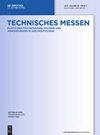Image Processing Forum – Forum Bildverarbeitung 2022
IF 0.7
4区 工程技术
Q4 INSTRUMENTS & INSTRUMENTATION
引用次数: 0
Abstract
For many technical applications, obtaining sensory information about objects, a scene or the environment is crucial. These include, for example, determining product quality in quality assurance and sensor-based sorting, sensing the environment for robotics and automated vehicles, and many other tasks in measurement and automation technology. In all of these applications, machine vision systems have key advantages over other sensor principles and over the inspection by humans: The actual observation process—image acquisition—is contact-free, the data have a high information content due to their multi-dimensional nature, and a variety of image acquisition methods can be used to capture very different properties of the scene with high informative value. What is outstanding about machine vision, however, is that it emulates the most important human sense—the visual sense—so that many image processing procedures can be understood relatively easily by humans. On the other hand, technical image acquisition is not bound to the limitations of the human sense of sight (e. g., spectral sensitivity, temporal response, temporal and spatial resolution, reproducibility, objectivity, fatigue). Cameras and the images they capture also play an increasing role in daily life, which is immediately apparent from the omnipresence of smartphones with (now often multiple) cameras. This is accompanied by a high level of maturity in sensor technology and image data processing, which in turn benefits the technical applications of image processing. In machine vision systems, components of various disciplines, including optics, lighting technology, sensor technology, signal processing, system theory, computer science and information technology, interact with each other to图像处理论坛-北京论坛2022
对于许多技术应用来说,获取物体、场景或环境的感官信息是至关重要的。其中包括,例如,在质量保证和基于传感器的分拣中确定产品质量,感知机器人和自动车辆的环境,以及测量和自动化技术中的许多其他任务。在所有这些应用中,机器视觉系统比其他传感器原理和人类检查具有关键优势:实际观察过程-图像获取-是无接触的,数据由于其多维性而具有高信息含量,并且可以使用各种图像获取方法来捕获具有高信息价值的场景的非常不同的属性。然而,机器视觉的突出之处在于,它模拟了人类最重要的感官——视觉——因此,许多图像处理过程可以相对容易地被人类理解。另一方面,技术图像采集不受人类视觉的限制(如光谱灵敏度、时间响应、时空分辨率、再现性、客观性、疲劳性)。相机和它们拍摄的图像在日常生活中也扮演着越来越重要的角色,这一点从无处不在的带有摄像头的智能手机(现在通常是多个摄像头)中显而易见。这伴随着传感器技术和图像数据处理的高度成熟,这反过来又有利于图像处理的技术应用。在机器视觉系统中,各个学科的组成部分,包括光学、照明技术、传感器技术、信号处理、系统理论、计算机科学和信息技术,相互作用
本文章由计算机程序翻译,如有差异,请以英文原文为准。
求助全文
约1分钟内获得全文
求助全文
来源期刊

Tm-Technisches Messen
工程技术-仪器仪表
CiteScore
1.70
自引率
20.00%
发文量
105
审稿时长
6-12 weeks
期刊介绍:
The journal promotes dialogue between the developers of application-oriented sensors, measurement systems, and measurement methods and the manufacturers and measurement technologists who use them.
Topics
The manufacture and characteristics of new sensors for measurement technology in the industrial sector
New measurement methods
Hardware and software based processing and analysis of measurement signals to obtain measurement values
The outcomes of employing new measurement systems and methods.
 求助内容:
求助内容: 应助结果提醒方式:
应助结果提醒方式:


